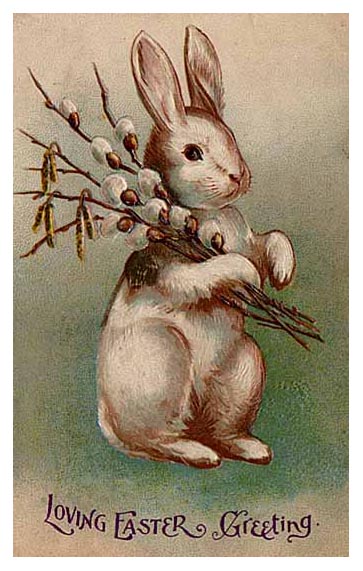
In medieval church art, the hare was a popular figure. It was believed by Pliny, Plutarch, and other philosophers and essayists in ancient times the hare was a hermaphrodite. The idea that a hare could reproduce without loss of virginity led to an association with the Virgin Mary. Hares occurred in illuminated manuscripts and northern European paintings of the Virgin and the Christ Child.
The Easter Rabbit is a folkloric figure and symbol of Easter depicted as a rabbit bringing Easter eggs. The German Lutherans originated the idea the Easter Hare played the role of determining whether children were good or disobedient at the season of Eastertide.

In legend, the rabbit carries colored eggs in his basket, candy, and toys to the homes of children. That custom was first mentioned in Georg Franck von Franckenau’sDe ovispaschaibus (About Easter Eggs) in 1682.
In his 1835 Deutsche Mythologie, Jacob Grimm stated that “The Easter Hare is unintelligible to me, but the hare was probably the sacred animal of Ostara.” In 1961 Christina Hole wrote “The hare was the sacred beast of Eostre, a Saxon goddess of Spring and of the dawn.” The belief that Eostre had a hare companion who became the Easter Bunny was popularized when presented as fact in a BBC documentary Shadow of the Hare in 1993.
Eggs were decorated during the Easter celebrations. German Protestants retained the custom of eating colored eggs for Easter, but did not adhere to the custom of fasting. Eggs boiled with some flowers changing their color. This brought Spring into their homes. The color green has been used to honor the new foliage emerging after the dormant time of Winter.
The Ukrainian art of decorating eggs for Easter is known as pysanky. This goes to ancient, pre-Christian times. Similar variants of this form of artwork can be seen among other eastern and central European cultures.
The idea of an egg-giving hare went to the U.S. in the 18th Century. Protestant German immigrants in the Pennsylvania Dutch area told their children about the “Osterhase.” Hase means hare and in northern European folklore the “Easter Bunny” indeed is a hare.
Have you heard of the phrase “Mad as a March hare?” This is an English idiomatic phrase derived from the observed antics said to occur only in the March breeding season of the European hare, Lepus europaeus. The phrase is an allusion that can be used to refer to any other animal or human who behaves in an excitable and unpredictable manner of a March hare.
A long-held view is that the hare will behave strangely and excitedly throughout its breeding season which in Europe has peaks in March. Some of the odd behavior includes boxing at other hares, jumping vertically for seemingly no reason, and generally displaying unusual behaviors An early verbal record of this animal’s strange behavior occurred in about 1500 in the poem Blowbol’s Testthat states ”Then they begin to swerve and to stare. And be as brainless as a March hare.”
John Skelton wrote in the 16th Century that “I saye, thou madde Marche Hare.” Sir Thomas More is recorded as writing that “As mad not as a March hare, but as a madde doge.” The phrase in general has been in continuous use since the 16th Century. It was popularized by Lewis Carroll in is 1865 children’s book Alice’s Adventures in Wonderland, in which the March hare is a memorable character.
Well, Thursday, April 1 is April Fool’s Day and Easter is Sunday, April 4. It is, indeed, a time to rejoice as we have traversed another Chicago Winter. Spring has arrived. Our spirits are revived. Life rushes back in all its glory and newness. Swimming is just around the corner, which, of course, depends on the temperatures. Let’s pray for temperatures in the 70s.
Happy Easter.

